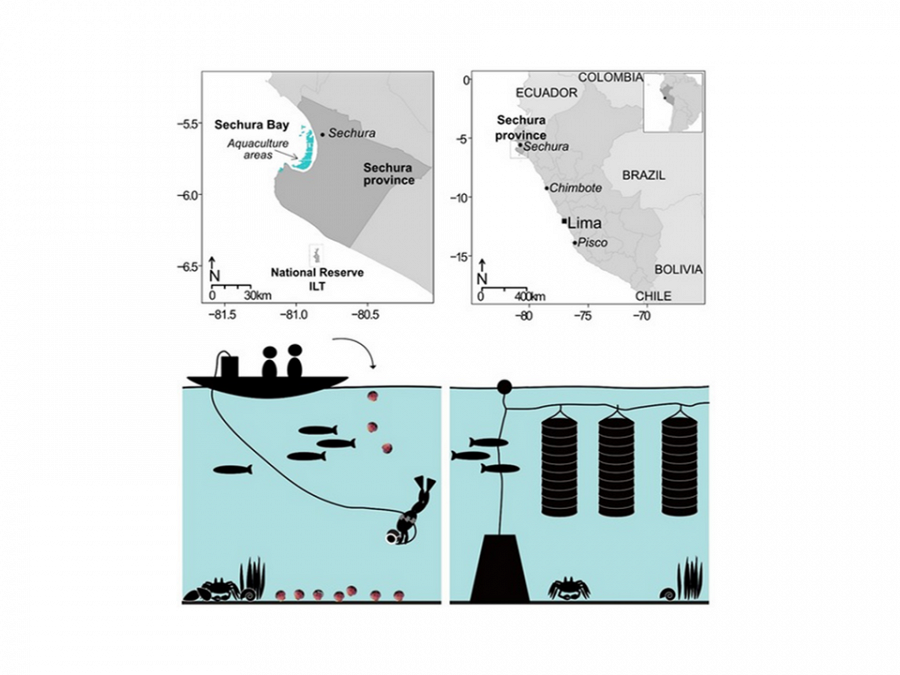New publication within the Humboldt Tipping Project: "Materialities, discourses and governance: scallop culture in Sechura, Peru"
05.05.2022

Aquaculture is the most quickly growing food sector worldwide: with an annual growth rate of 5.3% (for the period 2001–2018), the sector is expanding faster than other food-producing industries (FAO, 2020). It has a lot of potential in relation to food security and to solve sustainability issues in relation to wild-catch fisheries (e.g. Barange et al., 2014; Gentry et al., 2017). However, as it can be clearly observed, aquaculture is also not a silver bullet, but it comes along with social, economic and ecological challenges. Through the occupation of formerly open-access marine space, extensive aquaculture is regularly related to forms of sea grabbing, it capitalizes the sea and therewith often excludes the poor (Campling & Colas, 2021). And despite the global discourse often promoting aquaculture as the ultimate solution to meet the growing nutritional demand of the increasing world population, important parts of aquaculture production done in the global South produce seafood for export to Western markets (North America, European Union). It is not necessarily used for feeding local populations (Garlock et al., 2020). In many countries, small pelagic fish is reduced to fishmeal/oil to be used as feed input for aquaculture and is thus not available anymore for vital human consumption (Cashion et al., 2017; Majluf et al., 2017). Depending on the species cultured, aquaculture facilities interact with the surrounding environment in many ways, generating both costs and benefits at different social, economic and ecological scales (Kluger & Filgueira, 2021). Entire ecosystems may be destroyed, either because of space requirements or a high nutrient and pollution load (for an overview of aquaculture–environment interactions, see e.g. Edwards, 2015). Such a fast-growing sector, hardly existing 30 years ago, requires a lot of governance mechanisms to be developed allowing a sustainable path. This strong need for the development of governance mechanisms is sharply in contrast with the little amount of literature on the topic (Partelow et al., 2021).
Aquaculture production, might it be pond-based, or flow-through systems or mariculture, is always a highly interdependent social-ecological system (Asche et al., 2016; Naylor et al., 2021). The fluidity of water and the industrial intensity at which it takes place are just some of the reasons for those strong interdependencies. From this perspective, it seems obvious that, on the one hand, materialities of the natural but also human-made environments have a strong influence on the potential and possible governance regimes. On the other hand, the prevailing governance regime – due to the new emergence of the sector, it is often a laissez-faire regulation – has strong influences on the materialities, i.e. converting completely the appearance and functions of, for example, an estuary or bay. Not only that there is a lack of academic literature on governance challenges on aquaculture. Governance scholars, usually having a social science background, also focused for long mainly on social and economic characteristics influencing the governance regime (Bear, 2013; Epstein et al., 2013; Vogt et al., 2015) and only recently the material characteristics, the ecological fit gets more attention (Duineveld et al., 2017; Epstein et al., 2015). This is confirmed also for the field of aquaculture. Out of the roughly 2900 social science contributions to aquaculture in Scopus, nearly 1800 have an economic focus, in which marketing and supply chains play important roles. Roughly 600 papers research explicitly governance issues. Ecology plays a major role. However, an explicit perspective on materialities, might it be of nature, of products or technology is rare (19 out of which 14 come from the last five years; for example: Fairbanks, 2019). The special issue to which this paper is contributing to is aiming to fill that gap within environmental governance as a whole. This particular paper contributes to the fast expanding aquaculture sector. Having an understudied governance system like that of aquaculture, which is due to its characteristics highly interdependent on material properties, makes it a particular interesting study object.
This paper looks at the institutional emergence, particularly space rights, within the culture of the Peruvian bay scallop (Argopecten purpuratus) in Sechura Bay. The institutional system developed within a period of 20 years from an open-access, gold rush scenario to a rather structured, formal activity – however, still relies on a lot of informality. This work uses the matrix provided by the material dependency framework presented in this special issue distinguishing between nature, human and hybrid-made materialities that influence the emergence of institutional structures, on the one axis and path-, inter- and goal dependencies on the other axis. In this work, we argue that existing natural (high environmental risks associated with scallop culture in this setting), hybrid (need to process quickly) and human-made (export-oriented production) materialities have shaped different path dependencies in institutional development in favour of larger firms who gradually took over the control of scallop production from small-scale producers, who in turn became piece wage labourers. Yet, the realities of both actors are necessarily intertwined, with informal loop holes being intentionally left open, shaping different institutional solutions over time. Applying the material dependency framework shows how materialities and goal dependencies are intertwined in this particular case of scallop bottom aquaculture.
Find the original publication here:
https://www.tandfonline.com/doi/epub/10.1080/1523908X.2022.2047620?needAccess=true